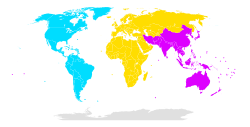9-centimeter band
The 9-centimeter band is a portion of the SHF (microwave) radio spectrum internationally allocated to amateur radio and amateur satellite use. The amateur radio band, in ITU regions 1 and 2, is between 3,300 MHz and 3,500 MHz, and it is available only on a secondary basis. The amateur satellite band is between 3,400 MHz and 3,410 MHz, and it is only available in ITU Regions 1 and 2, on a non-interference basis to other users (ITU footnote 5.282). In Germany and Israel, the band 3,400 - 3,475 MHz is also allocated to the amateur service on a secondary basis (ITU footnote 5.431).[1]
In CEPT's "European Common Allocation Table", footnote EU17 allocates 3,400 MHz to 3,410 MHz to European amateurs on a secondary basis.[2][3]
History
This section needs expansion with:
|
List of notable frequencies

- 3,400.1 MHz IARU Region-1 Calling frequency[3] and Global EME center of activity[3][4]
- 3,456.1 MHz IARU Region 2 Calling Frequency[4]
Radio Astronomy
3,332 - 3,339 MHz and 3345.8 - 3352.5 MHz are used by radio astronomers for spectral line observations.[4] Amateur stations voluntarily avoid using these frequencies when in geographic proximity to a radio telescope. ITU footnote 5.149 encourages all radio communications in the band to take practical steps to avoid harmful interference to radio astronomy observations in those frequency ranges.[1]
See also
Amateur radio frequency allocations
References
- ^ a b
"FCC Online Table of Frequency Allocations" (PDF). 47 C.F.R. Federal Communications Commission. August 13, 2015. Retrieved October 27, 2015.
{{cite web}}: Cite has empty unknown parameter:|deadurl=(help) - ^
Blondeel Timmerman, Hans (15 March 2009). "3300-3500 MHz". International Amateur Radio Union Region 1 Homepage. International Amateur Radio Union Region 1. Retrieved August 4, 2011.
EU17: In the sub-bands 3400-3410 MHz, 5660-5670 MHz, 10.36-10.37 GHz and 10.45-10.46 GHz the amateur service operates on a secondary basis. In making assignments to other services, CEPT administrations are requested wherever possible to maintain these sub-bands in such a way as to facilitate the reception of amateur emissions with minimal power flux densities.
{{cite web}}: Cite has empty unknown parameter:|deadurl=(help) - ^ a b c "VHF Managers Handbook" (PDF). 7. International Amateur Radio Union Region 1. January 2015. p. 48. Retrieved October 27, 2015.
- ^ a b c "IARU Region 2 Band Plan" (PDF). International Amateur Radio Union Region 2. September 27, 2013. pp. 11–12. Retrieved October 27, 2015.[permanent dead link]
